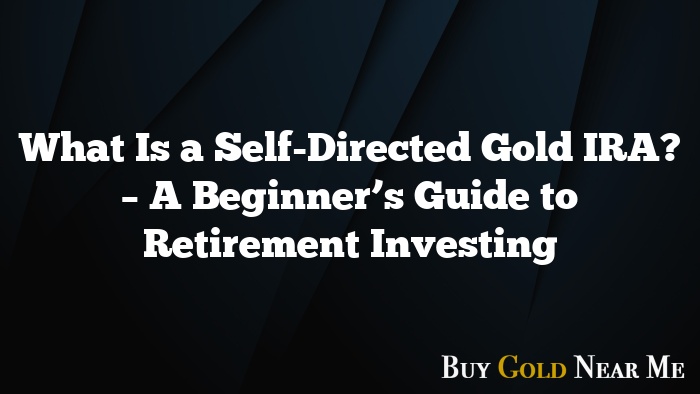What Is a Self-Directed Gold IRA? – A Beginner’s Guide to Retirement Investing
Exploring the Fascinating World of Self-Directed Gold IRAs
Self-directed gold IRAs have emerged as a powerful tool for savvy investors seeking to diversify their retirement portfolios. These specialized accounts offer a unique opportunity to allocate a portion of your savings to physical precious metals, providing a potential hedge against market volatility and inflation.
As you delve into the world of self-directed gold IRAs, you’ll discover a wealth of benefits and considerations that can help you make informed decisions about your financial future. From understanding the mechanics of how these accounts work to exploring the eligible gold assets and storage options, this comprehensive guide will equip you with the knowledge you need to navigate the self-directed gold IRA landscape.
| Key Features of a Self-Directed Gold IRA | Benefits |
|---|---|
| Ability to invest in physical precious metals | Potential hedge against market volatility and inflation |
| Tax-advantaged growth and distributions | Diversification of retirement portfolio |
| Custodian-managed storage and security | Ownership and control over your investments |
What is a Self-Directed Gold IRA?
A self-directed gold IRA is a type of individual retirement account (IRA) that allows you to invest in physical precious metals, such as gold, silver, platinum, and palladium. Unlike traditional IRAs that typically limit investments to stocks, bonds, and mutual funds, a self-directed gold IRA gives you the flexibility to diversify your retirement savings by including tangible assets like gold and other approved precious metals.
The key distinction of a self-directed gold IRA is that it is “self-directed,” meaning you, as the account holder, have the authority to make investment decisions and select the specific precious metal assets to be held within the account. This level of control and customization sets self-directed gold IRAs apart from their more conventional counterparts.
How Does a Self-Directed Gold IRA Work?
The process of establishing and managing a self-directed gold IRA involves several steps. First, you’ll need to open a self-directed IRA account with a specialized custodian or trustee who is authorized to hold and manage alternative assets like precious metals. These custodians are responsible for the storage, safekeeping, and administration of your gold and other eligible investments.
Once your self-directed gold IRA is set up, you can begin funding the account through a variety of methods, such as rollovers from an existing 401(k) or IRA, direct cash contributions, or transfers from other retirement accounts. With the funds in place, you can then work with your custodian to purchase the approved precious metal assets, which are typically in the form of gold bullion, coins, or bars.
It’s important to note that self-directed gold IRAs are subject to specific Internal Revenue Service (IRS) guidelines regarding the types of gold and other precious metals that are eligible for inclusion. Your custodian will be well-versed in these regulations and can provide guidance on the approved assets and storage requirements.
Key Benefits of Investing in a Self-Directed Gold IRA
The primary appeal of a self-directed gold IRA lies in its ability to provide diversification and potential protection against market volatility and inflation. By allocating a portion of your retirement savings to physical precious metals, you can help balance the risk inherent in traditional financial assets like stocks and bonds.
Diversification is a key benefit of a self-directed gold IRA, as it allows you to spread your retirement investments across different asset classes. This can help mitigate the impact of market downturns on your overall portfolio, potentially enhancing your long-term financial security.
Tax-advantaged growth and distributions are another significant advantage of a self-directed gold IRA. The account’s tax-deferred or tax-free status (depending on the type of IRA) allows your precious metal investments to grow without the immediate burden of taxes, potentially maximizing your retirement savings over time.
Furthermore, a self-directed gold IRA offers you ownership and control over your investments, enabling you to make informed decisions about the specific precious metals you want to hold in your retirement account.
Eligible Gold Assets for a Self-Directed IRA
The Internal Revenue Service (IRS) has established specific guidelines regarding the types of gold and other precious metals that are eligible for inclusion in a self-directed IRA. These approved assets typically include:
– Gold bullion in the form of bars or coins, provided they meet certain purity standards (typically 99.5% or higher)
– Gold coins issued by the United States Mint, such as American Eagle coins, as well as certain foreign gold coins
– Silver, platinum, and palladium bullion and coins that also meet the IRS’s purity requirements
It’s crucial to work closely with your self-directed IRA custodian to ensure that any precious metal investments you make comply with the IRS regulations. They can provide guidance on the eligible assets and help you navigate the acquisition and storage process.
Storing and Securing Your Gold Investment
One of the key considerations when investing in a self-directed gold IRA is the storage and security of your precious metal assets. The IRS requires that all gold and other approved metals held in a self-directed IRA be stored in an IRS-approved depository or vault, typically operated by the custodian or a third-party storage facility.
These specialized storage facilities are designed to provide the highest levels of physical security, insurance coverage, and regulatory compliance to protect your precious metal investments. Your custodian will handle the logistics of transporting, storing, and safeguarding your gold and other eligible assets on your behalf.
It’s important to note that the costs associated with storage and security are typically factored into the annual fees charged by your self-directed IRA custodian. Understanding these expenses is crucial when evaluating the overall cost-effectiveness of your self-directed gold IRA.
Funding Options for a Self-Directed Gold IRA
There are several ways to fund a self-directed gold IRA, each with its own advantages and considerations. The most common funding options include:
Rollovers from Existing Retirement Accounts – You can transfer funds from a 401(k), IRA, or other qualified retirement plan into your self-directed gold IRA, often without incurring immediate tax consequences.
Direct Cash Contributions – You can make annual cash contributions to your self-directed gold IRA, subject to the same contribution limits as traditional and Roth IRAs.
Transfers from Other IRAs – You can move assets from an existing IRA, such as a traditional or Roth IRA, into your self-directed gold IRA.
Regardless of the funding method you choose, it’s crucial to work closely with your self-directed IRA custodian to ensure the process is executed properly and in compliance with all applicable regulations.
Understanding the Tax Advantages
One of the primary advantages of a self-directed gold IRA is the tax-advantaged growth and distributions it can provide. Depending on the type of self-directed IRA you establish (traditional or Roth), you can benefit from either tax-deferred or tax-free growth and withdrawals.
In a traditional self-directed gold IRA, your contributions are typically made with pre-tax dollars, allowing your investments to grow tax-deferred until you begin taking distributions in retirement. This can help maximize the long-term growth potential of your precious metal holdings.
Conversely, a Roth self-directed gold IRA allows you to contribute post-tax dollars, but your qualified distributions in retirement are generally tax-free, providing the potential for tax-free growth and withdrawals.
It’s important to consult with a qualified financial advisor or tax professional to determine which type of self-directed gold IRA best aligns with your retirement goals and tax planning strategies.
Choosing a Custodian for Your Gold IRA
Selecting the right custodian is a crucial step in setting up a self-directed gold IRA. Your custodian will be responsible for the administrative and regulatory aspects of your account, including the acquisition, storage, and safekeeping of your precious metal investments.
When evaluating potential custodians, it’s essential to consider factors such as:
Experience and Reputation – Look for a custodian with a proven track record of managing self-directed IRAs and a reputation for providing excellent customer service.
Fees and Costs – Understand the custodian’s fee structure, including any setup fees, annual account maintenance fees, and storage/insurance costs, to ensure the overall cost-effectiveness of your self-directed gold IRA.
Regulatory Compliance – Ensure the custodian is fully compliant with all IRS and other regulatory requirements governing self-directed IRAs and the storage of precious metals.
By selecting a reputable and experienced custodian, you can have confidence that your self-directed gold IRA is in capable hands and that your precious metal investments are properly managed and secured.
Getting Started with a Self-Directed Gold IRA
If you’re interested in adding a self-directed gold IRA to your retirement portfolio, the first step is to research and identify a reputable custodian that specializes in these types of accounts. Many custodians offer educational resources and guidance to help you navigate the process of opening and funding your self-directed gold IRA.
Once you’ve selected a custodian, you’ll need to complete the necessary paperwork to establish your self-directed IRA account. This typically includes providing personal and financial information, as well as selecting the type of IRA (traditional or Roth) that best suits your retirement goals and tax planning needs.
With your self-directed gold IRA set up, you can then work with your custodian to fund the account and begin purchasing the eligible precious metal assets of your choice. Your custodian will handle the logistics of acquiring, storing, and securing your gold and other approved investments on your behalf.
Remember, it’s always a good idea to consult with a qualified financial advisor or tax professional to ensure that a self-directed gold IRA aligns with your overall retirement planning strategy and that you understand the potential risks and benefits associated with this type of investment.
Diversifying Your Retirement Portfolio
Incorporating a self-directed gold IRA into your retirement portfolio can be a strategic move to diversify your investments and potentially hedge against market volatility and inflation.
By allocating a portion of your retirement savings to physical precious metals, you can help create a more balanced and resilient portfolio. This diversification can provide a measure of stability during times of economic uncertainty, as gold and other precious metals have historically demonstrated the ability to maintain their value or even increase in times of market turmoil.
Moreover, the tax-advantaged growth and distributions offered by a self-directed gold IRA can further enhance the long-term performance of your retirement savings. This can be particularly beneficial as you approach and enter your golden years, providing an additional layer of financial security and peace of mind.
Avoiding Common Pitfalls
While self-directed gold IRAs offer numerous benefits, it’s essential to be aware of potential pitfalls and take steps to avoid them. Some common challenges to consider include:
Compliance with IRS Regulations – Ensure you work with a reputable custodian and strictly adhere to the IRS guidelines regarding eligible precious metal assets and storage requirements.
Excessive Fees – Carefully review the custodian’s fee structure to avoid high setup, maintenance, or storage costs that can erode the value of your precious metal investments.
Lack of Diversification – While gold can provide a valuable hedge, overconcentrating your retirement savings in a self-directed gold IRA may expose you to increased risk. Maintain a well-diversified portfolio.
By being mindful of these potential pitfalls and working closely with your custodian and financial advisor, you can navigate the self-directed gold IRA landscape with confidence and maximize the benefits it can provide for your retirement planning.
Frequently Asked Questions About Self-Directed Gold IRAs
What are the eligibility requirements for a self-directed gold IRA?
To be eligible for a self-directed gold IRA, you must meet the same basic requirements as a traditional or Roth IRA, such as having earned income and not exceeding certain income limits. Additionally, the precious metals you wish to invest in must meet the IRS’s purity standards and be stored in an approved depository.
Can I use my existing 401(k) or IRA to fund a self-directed gold IRA?
Yes, you can typically roll over or transfer funds from an existing 401(k), IRA, or other qualified retirement plan into a self-directed gold IRA. This allows you to consolidate your retirement savings and diversify into precious metals without incurring immediate tax consequences.
What are the annual contribution limits for a self-directed gold IRA?
The annual contribution limits for a self-directed gold IRA are the same as those for traditional and Roth IRAs, which are $6,000 for individuals under the age of 50 and $7,000 for those aged 50 and over (as of 2023). These limits are subject to change, so it’s important to stay up-to-date on the latest IRS guidelines.
Conclusion
Self-directed gold IRAs offer a compelling opportunity for investors seeking to diversify their retirement portfolios and potentially hedge against market volatility and inflation. By allocating a portion of your savings to physical precious metals, you can benefit from the tax-advantaged growth and distributions that these specialized accounts provide.
As you explore the world of self-directed gold IRAs, it’s essential to work with a reputable custodian, understand the eligible assets and storage requirements, and carefully consider the potential risks and benefits to ensure this investment aligns with your long-term financial goals. With the right guidance and a well-diversified portfolio, a self-directed gold IRA can be a valuable addition to your retirement planning strategy.
Can I hold physical gold in my self-directed gold IRA?
Yes, one of the key features of a self-directed gold IRA is the ability to hold physical gold, such as gold bullion and coins, within the account. The IRS has specific guidelines regarding the purity and types of gold that are eligible for inclusion in a self-directed IRA.
How do I choose a custodian for my self-directed gold IRA?
When selecting a custodian for your self-directed gold IRA, it’s important to consider factors such as their experience, reputation, regulatory compliance, and fee structure. Look for a custodian that specializes in alternative assets like precious metals and has a proven track record of providing excellent customer service and secure storage solutions.
What are the potential risks associated with a self-directed gold IRA?
While self-directed gold IRAs offer numerous benefits, it’s important to be aware of potential risks, such as the volatility of precious metal prices, the risk of theft or loss during storage, and the potential for excessive fees charged by the custodian. Careful research and diversification within your retirement portfolio can help mitigate these risks.







